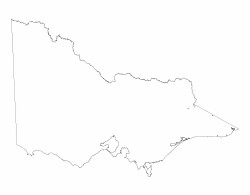1.4.1 Prominent summits above 1200 m (Mt Feathertop, Mt Howitt, Mt Buller)
1. Eastern Uplands (EU)
1.4 Dissected landscapes at a range of elevations
| The prominent summits are either culminations on ridge crests such as Mt. Howitt (1 737 m) and Mt. Feathertop (1 922 m) or rocky residuals above sub- planar surfaces such as the several peaks of The Cobberas. These summits typically rise only 200 to 300 m above the level of their surroundings. The absence of sharp peaks, with few exceptions such as Mt. Feathertop and Snowy Bluff (1 481 m), and general straight to convex bounding slopes distinguish most of these peaks from summit peaks of the northern hemisphere. Extensive surface rock occurs, with tors e.g. at The Horn on the granitic plateau of Mt. Buffalo (1 719 m), and beneath a weathered mantle, hard parent rock is widely evident in most prominent summits of the Eastern Uplands. Sharp peaks (in addition to Mt Feathertop and Snowy Bluff), include The Razor, The Viking and The Crosscut Saw in the western part of the Barry Mountains. Apart from Mt. Feathertop, their shapes are strongly influenced by the presence of moderately inclined beds of hard Upper Devonian lavas, sandstone and conglomerate. Conspicuous ridge high points, with forms reflecting hard, moderately-dipping Upper Devonian rocks, include Mt. Howitt (1 737 m), Mt. McDonald (1 625 m), where the Wellington Plateau terminates abruptly on the south at Gable End (1 570 m), and Castle Hill (1 448 m). The Cathedral Range near Buxton is a razorback following the dip of Devonian sandstones. Peaks with shapes not significantly reflecting their geology include Mt Buller (1 804 m), Mt. Stirling and Mt. Gibbo (1 757 m). |  |
Noticeable high points on plateau-like surfaces are The Cobberas (1 832 m), Mt. Delegate(1 308 m), Mt. Nelse (1 910 m) and Mt. Tamboritha (1 640 m).
Because of their high elevation, these summits experience great climatic extremes. They are often snow covered in winter, and the climate limits the vegetation to life forms and species that can survive great temperature variability and often severe drought. Exposure to the severe winds at these elevations, predominantly from the west, results in great differences between aspects in both soils and vegetation
The soils are usually shallow and contain abundant rock fragments, typically core-stones of less-weatherable material that often appear as stone-lines that indicate a zone of separation between two bodies of soil material that have different pedogenic origins. Deeply weathered regolith typically underlies the soils.
Periglacial features (e.g. talus or scree slopes, frost shattered rocks and possibly the stone-lines mentioned above) indicate that severe freeze-thaw processes have certainly been active in the past and may still occasionally occur. Rock rivers near The Cobberas and solifluction deposits near Mt Hotham are further evidence of periglaciation.


